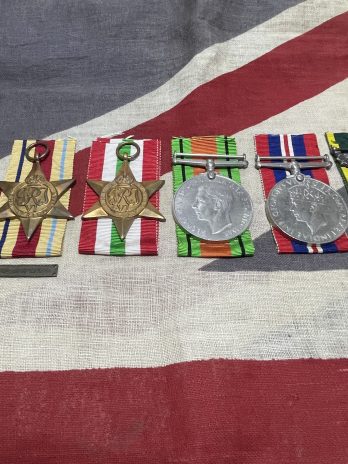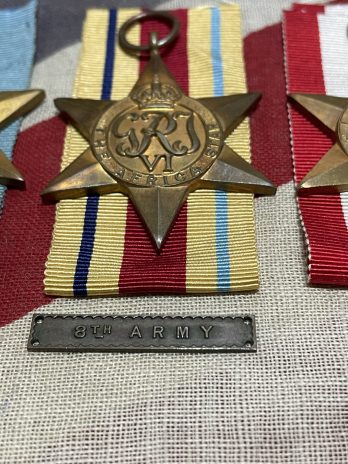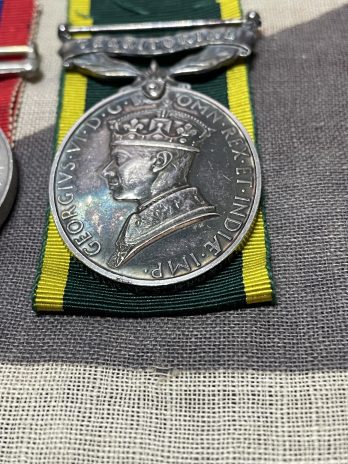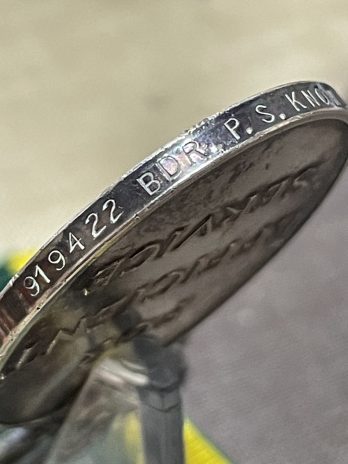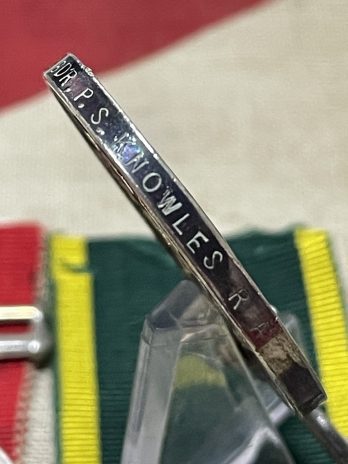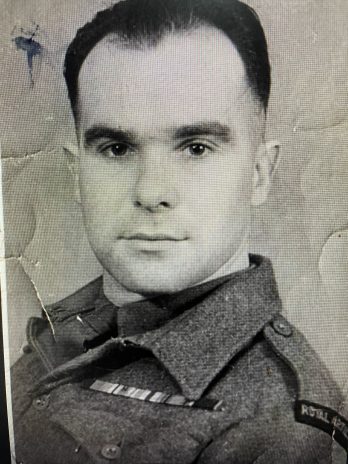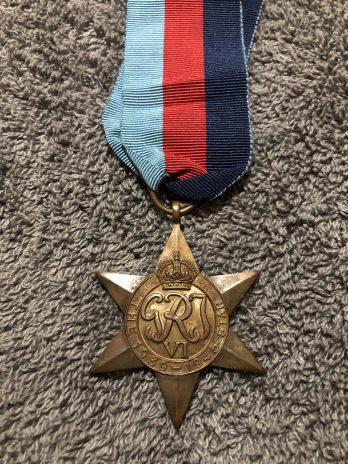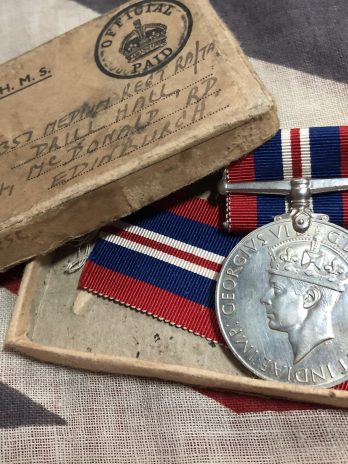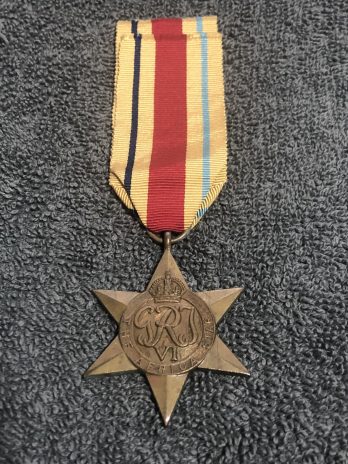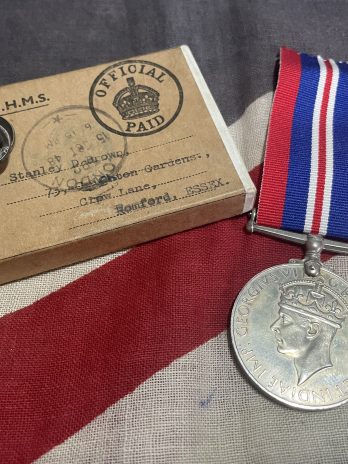WWII group of 6 consisting of the 39-45 Star, Africa Star with 8th Army clasp, Italy Star, War & Defence with a KGVI Territorial Efficiency Medal
The TEM correctly named to 919422 Bdr PS Knowles RA
Peter Stretton Knowles was born to Frank and Pauline in Deptford in 1918.
We see he attested into the Royal Artillery in 1939. He joined the 91st Field regiment RA.
He was sent overseas with the 53rd (Bolton) Field Regiment in July 1942.
After he was de-mobbed, aged 25, he married in 1949. An address on discharge is noted as ‘Delma’ Maberley Road, Beckenham, Kent.
We know Peter died in Sussex in 1998.
All medals have original unworn silk ribbons.
We were lucky to find a photo of Peter in uniform online.
Operations of the 53rd (Bolton) Field Regiment.
El Alamein
Once the regiment arrived in Egypt, the personnel of S A/T Battery left to join 149th (Lancashire Yeomanry) A/T Regiment on 19 September. Eighth Army was preparing for the decisive Second Battle of Alamein, for which 53rd Field Regiment was attached to 44th (Home Counties) Division.
44th (HC) Division was to lead one of XIII Corps’ thrusts through the enemy minefields on the first night, 23/24 October (Operation Lightfoot), following a massive artillery barrage. A route was found through the first belt of minefields (‘January’) on the first night and 44th (HC) Division succeeded in passing the second minefield (‘February’) the next night, but the armour was unable to exploit beyond. The second phase of the offensive, Operation Supercharge, was launched on the night of 27/28 October. Eventually, the armour broke though, and next day came signs that the enemy was withdrawing. 44th (HC) Division took some part in the pursuit to El Agheila, collecting prisoners, but XIII Corps was short of transport and was left behind as Eighth Army drove westwards. Shortly afterwards 44th (HC) Division HQ was disbanded, and its units distributed.
Iraq
53rd Field Regiment now became an army level unit in Middle East Forces. The regiment moved to Iraq, arriving on 3 January 1943, when it came under the command of 8th Indian Division (along with 52nd (Manchester) Field Regiment). The division was in Tenth Army, forming part of Paiforce defending the vital oilfields of Iraq and Persia and the line of communications with the Soviet Union. By the spring of 1943 the victories in North Africa and on the Eastern Front had removed the threat to the oilfields, and troops could be released from Paiforce for other theatres. 8th Indian Division moved to Ninth Army in Syria with 53rd Field Regiment arriving on 30 April 1943.
8th Indian Division was then selected for the forthcoming Italian Campaign. 53rd Field Regiment arrived back in Egypt on 13 September and then embarked with the division for Italy on 18 September.
Italy
8th Indian Division began disembarking at Brindisi on 23 September, where 53rd Field Regiment arrived next day. The division joined V Corps, which was leading Eight Army’s advance up the east coast of Italy. Operations were slowed by rain and mud, but on the night of 1/2 November 8 Indian Division began attacking across the River Trigno, part of the Barbara Line. 1st Battalion 13th Frontier Force Rifles fought its way up the wooded spurs against the German 3rd Parachute Regiment, and the following night 3rd Bn 8th Punjab Regiment crossed the river to add its weight. On the night of 3/4 November the two battalions attacked Tufillo, ‘taking in their stride a German counter-attack which was blown to pieces by the divisional artillery’. There was confused fighting in the dark amongst burning scrub, and by morning the two battalions were pinned down under heavy fire. The Germans were however being forced to thin out their defences, and the paratroopers withdrew, allowing the whole of 8th Indian Division to advance.
Mozzagrogna
The Germans took up another delaying position, the Bernhardt Line, behind the River Sangro. Eighth Army closed up to the river on 9 November and prepared to assault the position. 78th Division developed a bridgehead, and on 27 November, after the flooded river had fallen, 8th Indian Division took Mozzagrogna on the escarpment beyond. A German counter-attack recaptured the village early on 28 November, but a fresh attack by 1st Bn 12th Frontier Force Regiment, accompanied by all the divisional and corps artillery, finally captured it by 01.30 on 29 November. The following night 1st Bn 5th Royal Gurkha Rifles and 1/12th FFR captured the dominating ground beyond Mozzagrogna, completing the rupture of the Bernhardt Line. The division continued to advance with short, powerfully supported attacks against stubborn resistance, where artillery ammunition supply became the limiting factor. Winter weather brought an end to operations in late December.
During the fighting on the Sangro the former footballer Harry Goslin, by then a lieutenant with a Military Cross, was killed by mortar fire on 18 December while acting as a forward observation officer for his battery.
Monte Cassino
Eighth Army regrouped during the winter months, and 8th Indian Division moved to XIII Corps for the Spring offensive. This corps would be operating in the Liri Valley as part of the renewed attack on Monte Cassino (Operation Diadem). First XIII Corps carried out a setpiece assault crossing of the Rapido or Gari River (part of the German Gustav line), with an artillery programme starting at 23.00 on 11 May. Every gun was employed for the next 12 hours in counter-battery (CB) and counter-mortar fire, with the field guns concentrating on the German mortars and Nebelwerfers. At 00.45 on 12 May 8th Indian Division launched its assault boats and the field guns switched to providing a Creeping barrage, followed by timed concentrations on selected targets. A dense mist screened the assault points but caused confusion for the attackers and both attacking brigades got left behind by the barrage. Nevertheless, after hard fighting they achieved a bridgehead and before nightfall the Sappers had laid two bridges to allow tanks to cross. Next day 1/5th Gurkha Rifles, supported by tanks and seven field artillery regiments, took the village of San Angelo at the third attempt, and on 14 and 15 May the division cleared the tongue of land between the Liri and the Gari and pressed on westwards as the Germans fell back to the Hitler Line.
The artillery had to be brought up before the next bound, the advance north of the Liri on 25 May, but then its CB fire totally suppressed the German artillery, which fell silent every time an Air Observation Post spotter aircraft appeared. While the armoured divisions advanced up the roads, the lightly equipped 8th Indian Division took to the narrow tracks through the hills, driving German rearguards from the hilltop towns. On the night on 1/2 June the division moved cross-country to Vico nel Lazio, bridging streams and gullies as it went and reaching the town on the afternoon of 3 June. The Germans then pulled back to the Trasimene Line and Fifth US Army entered Rome next day.
For the pursuit to Lake Trasimeno, 8th Indian Division came under X Corps, leading its advance on minor roads through the hill country east of Rome. Perugia was captured without much opposition on 19/20 June, then X Corps struck north up the Tiber valley, with 8th Indian Division making for Sansepolcro. On 26 June it caught an unprepared German division and inflicted heavy casualties. 8th Indian Division had been in almost continuous fighting for nine months, and was now relieved for rest and refit.
Operation Olive
8th Indian Division returned to the front line with XIII Corps in the Elsa Valley later in July. The corps employed its overwhelming superiority in artillery to drive towards Florence, which the Germans evacuated. The forces then had to be regrouped to attack the Gothic Line in Operation Olive. 8th Indian Division crossed the River Arno in a preliminary operation on 21 August, and then advanced into the roadless mountains where it could not take its artillery. It captured Monte Femmina Morta on 18 September, easing the advance through the Casaglia Pass. Afterwards it advanced down the Faenza road, opening the routes into the Lamone Valley for heavy equipment and supplies, but further progress through the mountains was slow. The gunners had particular problems in firing over crests to hit targets behind. The division maintained pressure on the German positions during October to prevent them moving troops elsewhere. Artillery ammunition had to be rationed from November, but 8th Indian Divisional Artillery, operating in the critical junction between Eighth Army and Fifth US Army, was exempt and received ample supplies. The division kept up small offensive operations into the winter, despite the supply difficulties in the mountains. On 26 December the Germans launched a counter-attack (the Battle of Garfagnana) between Lucca and Pistoia towards Livorno, but 8th Indian Division had already been rushed west to bolster the US sector concerned. The Germans broke through until they were stopped at the Indians’ positions, when 8th Indian Division took over control of the sector, but the German attack was not pressed. The division was relieved for rest on 8 January 1945.
Operation Grapeshot
8th Indian Division was back with Eighth Army for the Allies’ spring offensive in Italy, Operation Grapeshot. It was given the task of an assault crossing of the River Senio, with massive artillery support added to its own guns, and ample ammunition stocks built up during the winter. The German positions, dug into the floodbank of the river, presented a challenging linear target, so many of the guns fired in enfilade from the flanks. The operation was launched on 9 April. At 15.00 the assault troops withdrew to a safe distance while the artillery and air bombardment was carried out. Then at 19.20 the assault infantry went in, with a protective barrage laid on the far side of the river. Opposition remained strong on 8th Indian Division’s front, but after bitter fighting through the night it secured its objectives by midday on 10 April. It then fought its way forward to the River Santerno and secured crossings during the night of 11/12 April. 78th Division then passed through 8th Indian Division to continue the advance. As Eighth Army advanced towards the River Po, 8th Indian Division came back into the widening line, attacking up the Via Adriatica until it ran into opposition at the airfield south-west of Ferrara on 22 April. After a 36-hour fight the division thrust round the western city of the city and got to the Po on 23 April, possibly the first troops of Eighth Army to reach it. The division then planned for another assault crossing, but German resistance was crumbling and opposition to its crossing on the night of 25/26 April was negligible. The division was then ‘grounded’ as its transport was taken to support Eighth Army’s rapid drive to Venice and Trieste.
Hostilities on the Italian Front ended on 2 May with the Surrender of Caserta, but 8th Indian Division had already been withdrawn from the line on 29 April. It had been selected as the first Indian formation to transfer from Italy to the Far East theatre to fight the Japanese. It left in June 1945, when all the British units attached to it reverted to the British establishment and returned home. 53rd Field Regiment and the other units had been overseas for over two years and most of their personnel were due for repatriation under the government’s ‘Python’ scheme. 53rd (Bolton) Field Regiment embarked for the UK on 20 June. Back in the UK it was re-organised as 53rd (Field) Holding Regiment (with four batteries designated A to D) to handle gunners being reposted and awaiting demobilisation. It passed into suspended animation on 2 June 1946








